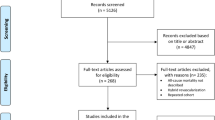Abstract
Percutaneous coronary intervention (PCI) has evolved as the standard procedure for the treatment of acute coronary syndromes and for the majority of situations with stable coronary artery disease. Patients aged 75 and older represent one third of those hospitalised with acute ischaemic events and account for more than half of all cardiac deaths. 1 However, evidence-based data to guide coronary revascularisation in the elderly have been limited to 1) the randomised clinical trials that routinely under-enrol elderly patients, and 2) observational studies that represent single institution experience with small samples. 2 Nevertheless, the Western society is an ageing population and the percentage of the population above 80 years of age, the so-called octogenarians, is rapidly increasing in Europe and will almost triple by 2050. 3
Similar content being viewed by others
References
Goldberg RJ, Yarzebski J, Lessard D, Gore JM. A two-decades (1975-1995) long experience in the incidence in-hospital and long term case-fatality rates of acute myocardial infarction: a community-wide perspective. J Am Coll Cardiol 1999;33:1533-9.
Feldman DN, Gade CL, Slotwiner AJ, Parikh M, Bergman G, Wong SC, et al. Comparison of the outcomes of percutaneous coronary interventions in patiens of three age groups (<60, 60 to 80, and >80 years) (from New York State Angioplasty Registry). Am J Cardiol 2006;98:1334-9.
Ministry for internal affairs of the Federal Republic of Germany http://www.bmi.bund.de/nn_882848/Internet/Navigation/DE/Themen/Bevoelkerungsentwicklung/bevoelkerungsentwicklung_node.html_nnn=true
Batchelor WB, Anstrom KJ, Muhlbaier LH, Grosswald R, Weintraub WS, O’Neil WW, et al. Contemporary outcome trends in the elderly undergoing percutaneous coronary interventions: Results in 7,472 octogenerians. J Am Coll Cardiol 2000;36:723-30.
Günal A, Aengevaeren WRM, Gehlmann HR, Luijetn JE, Bos JS Verheugt FWA. Outcome and quality of life one year after percutaneous coronary interventions in octogenarians. Neth Heart J 2008;16:117-22.
Yan BP, Gurvitch R, Duffy SJ, Clark DJ, Sebastian M, New G, et al. An evaluation of octogenarians undergoing percutaneous coronary intervention from the Melbourne Interventional Group registry. Catheter Cardiovasc Interv 2007;70:928-36.
Mehta RH, Granger CB, Alexander KP, Bossone E, White HD, Sketch Jr MH. Reperfusion strategies for acute myocardial infarction in the elderly: benefits and risks. J Am Coll Cardiol 2005; 45:471-8.
Author information
Authors and Affiliations
Corresponding author
Additional information
Department of Cardiology, Maastricht University Hospital, and Cardiovascular Research Institute Maastricht (CARIM), University of Maastricht, Maastricht, the Netherlands
Correspondence to: J. Waltenberger Department of Cardiology, Maastricht University Hospital and Cardiovascular Research Institute of Maastricht (CARIM), PO Box 5800, 6202 AZ Maastricht, the Netherlands
Rights and permissions
About this article
Cite this article
Waltenberger, J., Vainer, J. PCI comes to age as age increasingly comes to PCI. NHJL 16, 115–116 (2008). https://doi.org/10.1007/BF03086128
Issue Date:
DOI: https://doi.org/10.1007/BF03086128




